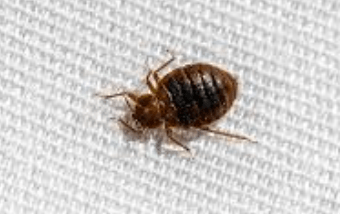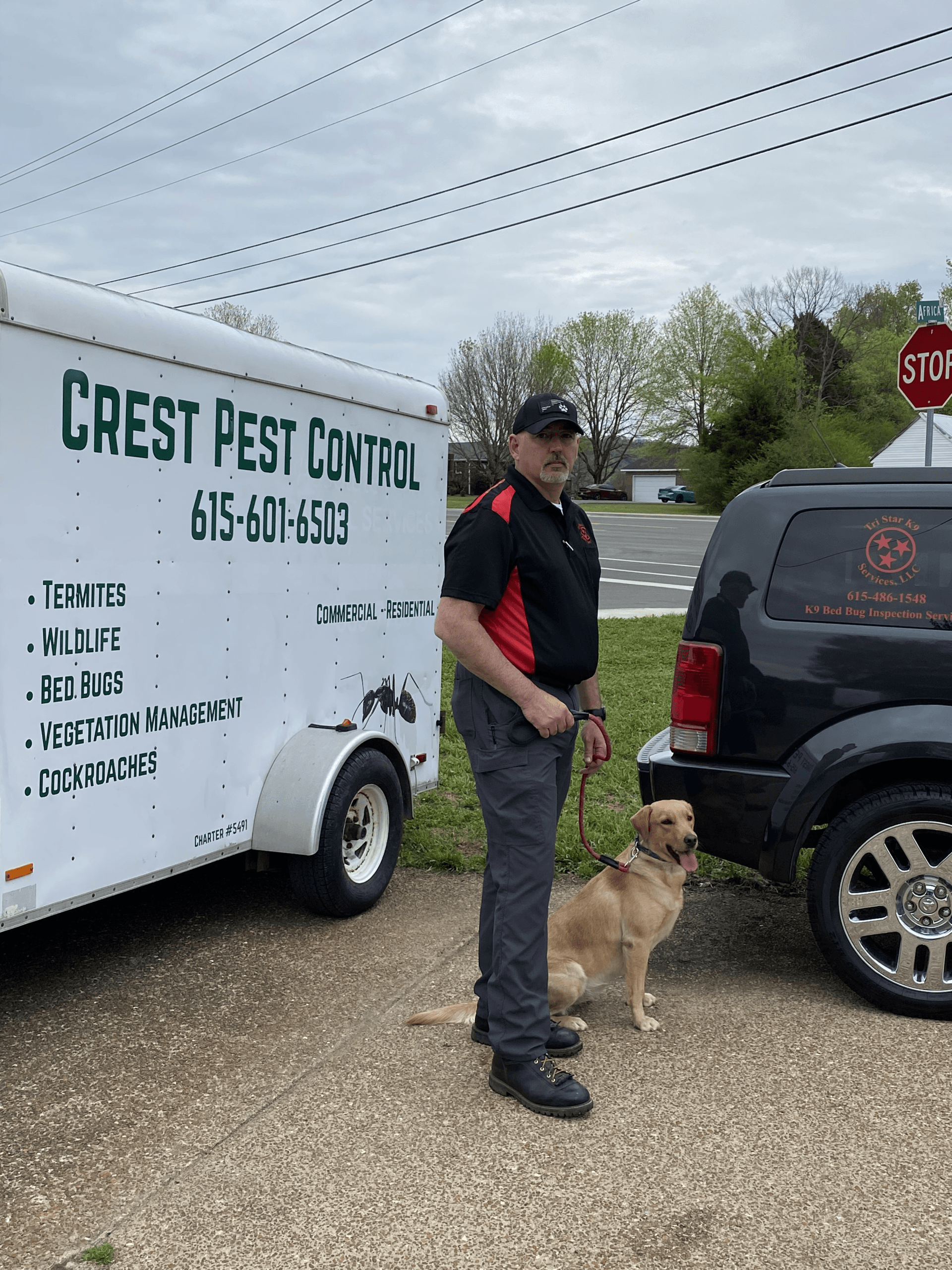BED BUG CONTROL
What are bed bugs?
Bedbugs are small, flat, parasitic insects that feed solely on the blood of people and animals while they sleep. Bed bugs are reddish-brown in color, wingless, range from 1mm (roughly the size of the letters on a penny) to 5mm (roughly the size of Lincoln’s head on a penny), and can live up to a year without a blood meal. Bed bugs don't jump or fly, and they crawl about the same speed as an ant.
How did I get bed bugs?
The most common way for bed bugs to invade your home is for your family, or your friends to bring them in without realizing it. Bed bugs are excellent “hitch-hikers.” Here are some ways you could bring them into your home:
• Picking up bed bug-infested beds, or furniture that has been discarded.
• Visiting someone who has bed bugs and carrying them back with you on your clothing or possessions.
• Staying overnight in a bed bug-infested hotel or home and bringing them home in your luggage.
• Renting furniture infested with bed bugs from rental companies.
• Buying bed bug-infested second-hand furniture, carpets, blankets, luggage, pictures, and fixtures from stores, yard sales, auctions, and flea markets.
• Bedbugs can also migrate from one apartment to the next through pipe and wiring runs, and through wall and ceiling voids, in the same way that cockroaches move between apartments.
Do bed bugs spread disease?
Bed bugs are not known to spread disease and not be considered a medial hazard. Bed bugs can be an annoyance because their presence may cause itching and loss of sleep. The itching can lead to excessive scratching that could increase the chance of a secondary skin infection.
K9 Bed Bug Inspections vs. Traditional Inspections
Accuracy
While no bed bug inspection can be 100% accurate, the use of a trained K-9 bed bug inspection team is the most accurate means of detection available. K-9 units detect adult bed bugs, nymphs, and eggs with 97% accuracy, whereas traditional inspections can only detect bed bugs with approximately 40-60% accuracy.
Duration
Inspection durations ranging from 2-15 minutes per room for K-9 units. Traditional Inspections require between 20 minutes and an hour per room.
Disruption
There is minimal or even no disruption to the occupant(s) with K-9 unit inspections. Traditional inspections require a moderate level of disruption to the occupant (dismantling beds, moving furniture, etc.).
Limitations
K-9 unit detection has no limitations in cluttered areas, inside upholstered surfaces, mattress seams, beneath the carpet, behind baseboards, etc. Traditional inspections are limited to inspecting only what they can see.
Call us at 615-601-6503 or fill out our contact form today for more information about bed bugs.
What are bed bugs?
Bedbugs are small, flat, parasitic insects that feed solely on the blood of people and animals while they sleep. Bed bugs are reddish-brown in color, wingless, range from 1mm (roughly the size of the letters on a penny) to 5mm (roughly the size of Lincoln’s head on a penny), and can live up to a year without a blood meal. Bed bugs don't jump or fly, and they crawl about the same speed as an ant.
How did I get bed bugs?
The most common way for bed bugs to invade your home is for your family, or your friends to bring them in without realizing it. Bed bugs are excellent “hitch-hikers.” Here are some ways you could bring them into your home:
• Picking up bed bug-infested beds, or furniture that has been discarded.
• Visiting someone who has bed bugs and carrying them back with you on your clothing or possessions.
• Staying overnight in a bed bug-infested hotel or home and bringing them home in your luggage.
• Renting furniture infested with bed bugs from rental companies.
• Buying bed bug-infested second-hand furniture, carpets, blankets, luggage, pictures, and fixtures from stores, yard sales, auctions, and flea markets.
• Bedbugs can also migrate from one apartment to the next through pipe and wiring runs, and through wall and ceiling voids, in the same way that cockroaches move between apartments.
Do bed bugs spread disease?
Bed bugs are not known to spread disease and not be considered a medial hazard. Bed bugs can be an annoyance because their presence may cause itching and loss of sleep. The itching can lead to excessive scratching that could increase the chance of a secondary skin infection.
K9 Bed Bug Inspections vs. Traditional Inspections
Accuracy
While no bed bug inspection can be 100% accurate, the use of a trained K-9 bed bug inspection team is the most accurate means of detection available. K-9 units detect adult bed bugs, nymphs, and eggs with 97% accuracy, whereas traditional inspections can only detect bed bugs with approximately 40-60% accuracy.
Duration
Inspection durations ranging from 2-15 minutes per room for K-9 units. Traditional Inspections require between 20 minutes and an hour per room.
Disruption
There is minimal or even no disruption to the occupant(s) with K-9 unit inspections. Traditional inspections require a moderate level of disruption to the occupant (dismantling beds, moving furniture, etc.).
Limitations
K-9 unit detection has no limitations in cluttered areas, inside upholstered surfaces, mattress seams, beneath the carpet, behind baseboards, etc. Traditional inspections are limited to inspecting only what they can see.
Call us at 615-601-6503 or fill out our contact form today for more information about bed bugs.
What are bed bugs?
Bedbugs are small, flat, parasitic insects that feed solely on the blood of people and animals while they sleep. Bed bugs are reddish-brown in color, wingless, range from 1mm (roughly the size of the letters on a penny) to 5mm (roughly the size of Lincoln’s head on a penny), and can live up to a year without a blood meal. Bed bugs don't jump or fly, and they crawl about the same speed as an ant.
How did I get bed bugs?
The most common way for bed bugs to invade your home is for your family, or your friends to bring them in without realizing it. Bed bugs are excellent “hitch-hikers.” Here are some ways you could bring them into your home:
• Picking up bed bug-infested beds, or furniture that has been discarded.
• Visiting someone who has bed bugs and carrying them back with you on your clothing or possessions.
• Staying overnight in a bed bug-infested hotel or home and bringing them home in your luggage.
• Renting furniture infested with bed bugs from rental companies.
• Buying bed bug-infested second-hand furniture, carpets, blankets, luggage, pictures, and fixtures from stores, yard sales, auctions, and flea markets.
• Bedbugs can also migrate from one apartment to the next through pipe and wiring runs, and through wall and ceiling voids, in the same way that cockroaches move between apartments.
Do bed bugs spread disease?
Bed bugs are not known to spread disease and not be considered a medial hazard. Bed bugs can be an annoyance because their presence may cause itching and loss of sleep. The itching can lead to excessive scratching that could increase the chance of a secondary skin infection.
K9 Bed Bug Inspections vs. Traditional Inspections
Accuracy
While no bed bug inspection can be 100% accurate, the use of a trained K-9 bed bug inspection team is the most accurate means of detection available. K-9 units detect adult bed bugs, nymphs, and eggs with 97% accuracy, whereas traditional inspections can only detect bed bugs with approximately 40-60% accuracy.
Duration
Inspection durations ranging from 2-15 minutes per room for K-9 units. Traditional Inspections require between 20 minutes and an hour per room.
Disruption
There is minimal or even no disruption to the occupant(s) with K-9 unit inspections. Traditional inspections require a moderate level of disruption to the occupant (dismantling beds, moving furniture, etc.).
Limitations
K-9 unit detection has no limitations in cluttered areas, inside upholstered surfaces, mattress seams, beneath the carpet, behind baseboards, etc. Traditional inspections are limited to inspecting only what they can see.
Call us at 615-601-6503 or fill out our contact form today for more information about bed bugs.

Myths and facts about bed bugs
Some people are not affected by bed bugs bites.
True: Some people do not have a physical reaction to bed bug bites. They may be unaware that bed bugs are in their home until they actually see them.
Bed bug bites all look the same.
False: They can be small and red or bigger like welts. Some people don't react at all to a bed bug bite. It is almost impossible to diagnose a bed bug problem solely on the presence of bites on a human host.
Bed bug bites are easily felt.
False: You do not feel a bed bug biting because they inject their saliva first which contains an anesthetic, numbing chemical and an anti-clotting agent so your blood flows freely.
Bed bugs reproduce at alarming rates.
True: Depending on conditions, bed bugs can produce three or four generations in one year; a female can produce one to five eggs a day, which are as big as a pinhead and can hardly be seen.
Pesticides will kill all bed bug stages.
False: It is difficult to kill all bed bugs with only a pesticide application. Successful treatment depends on an Integrated Pest Management approach to bed bug control which involves, vacuuming, and steaming, encasing mattress and box spring, interception devices and chemical treatment.
I can get rid of bed bugs by leaving my house empty for a few weeks.
False: Adult bed bugs can live as long as twelve months without a meal, so a long vacation won't provide you with relief. The only way to deal with the problem is to treat it directly and monitor results over the long haul.

Slide title
Write your caption hereButton
Slide title
Write your caption hereButton
Slide title
Write your caption hereButton
Crest Pest Control LLC
Phone: 615-601-6503
Crest Pest Control TN CH 5491
Website by Webact | Denver Web Design
